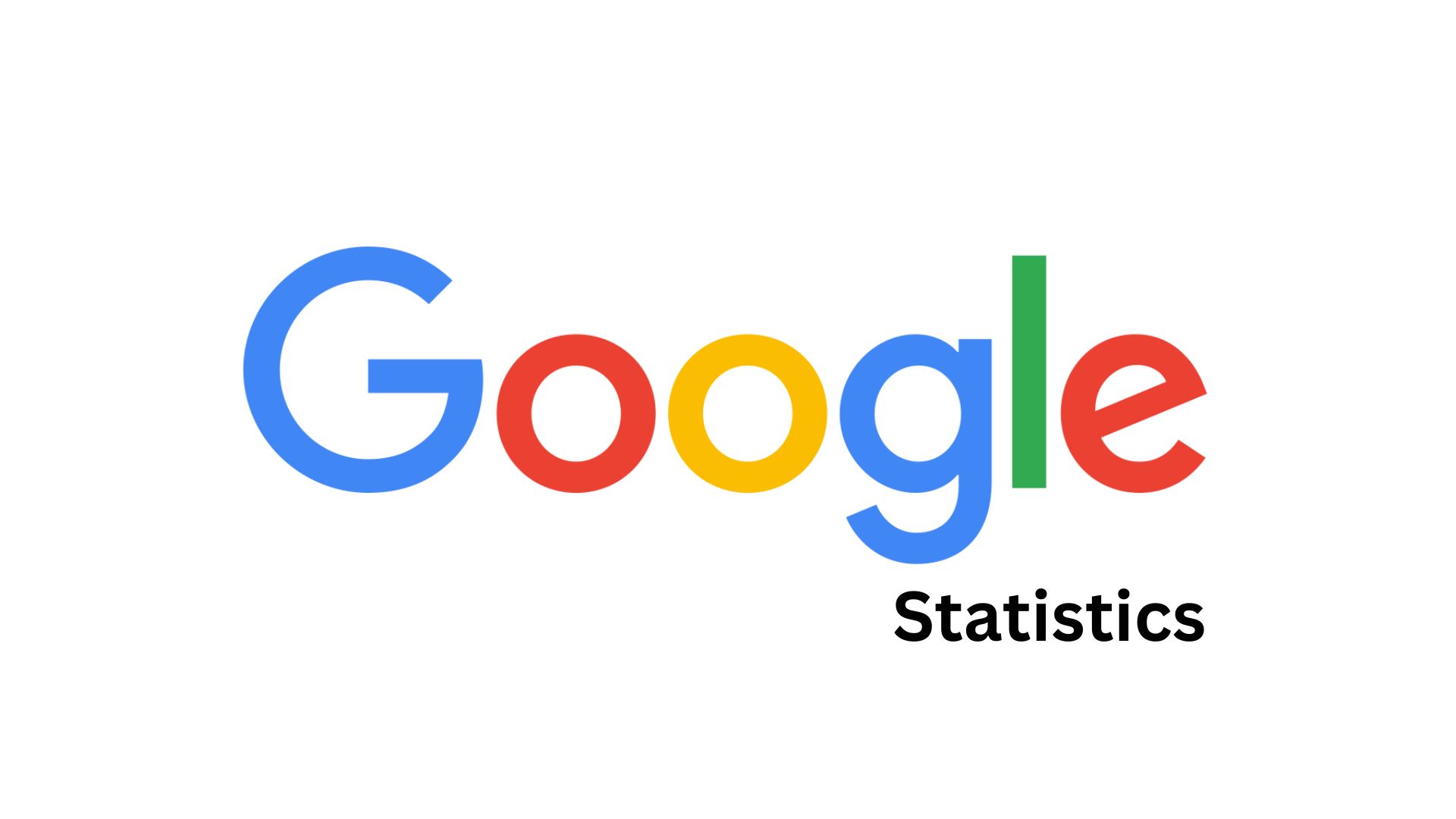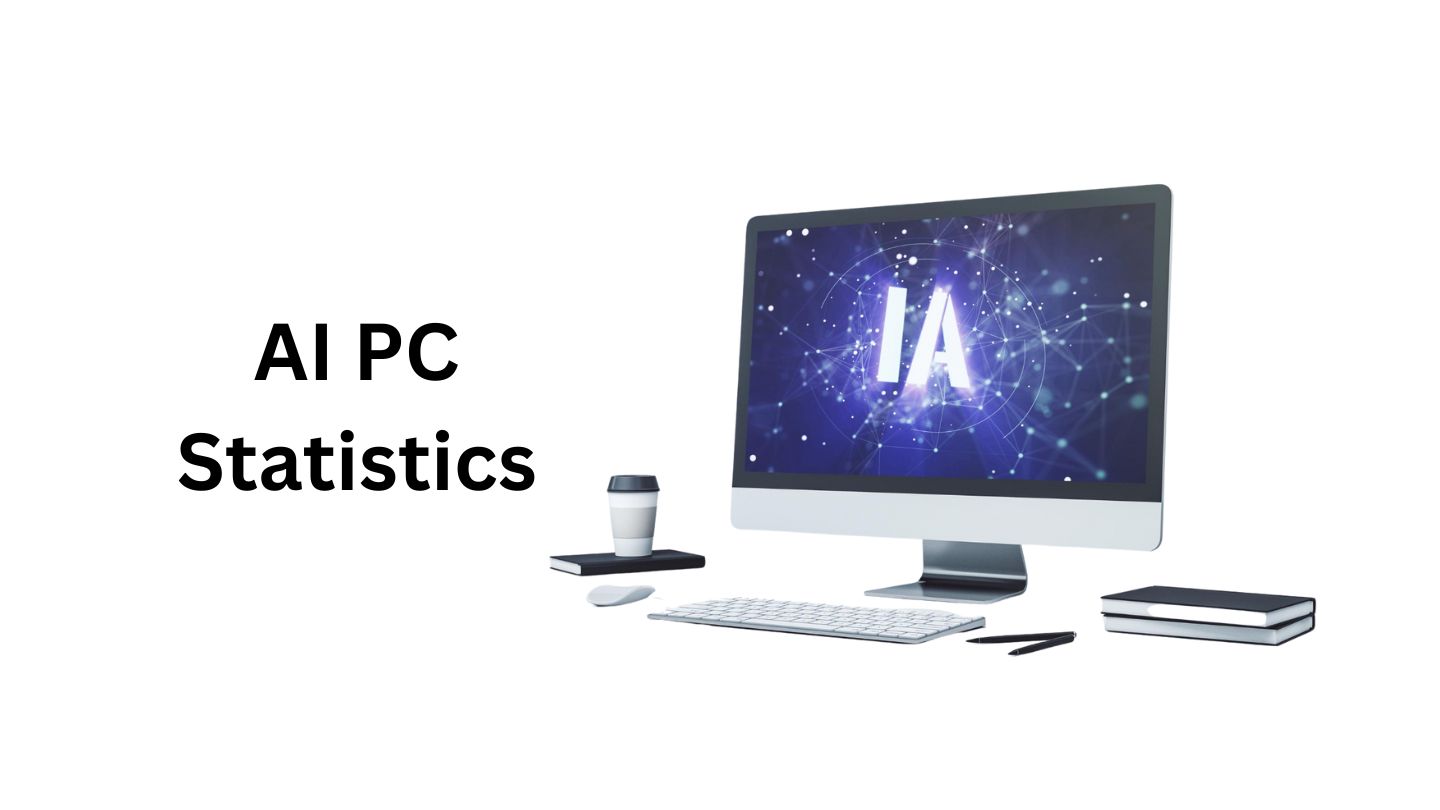6G Statistics By Usage, Market Size and Facts (2025)
Updated · Nov 25, 2025
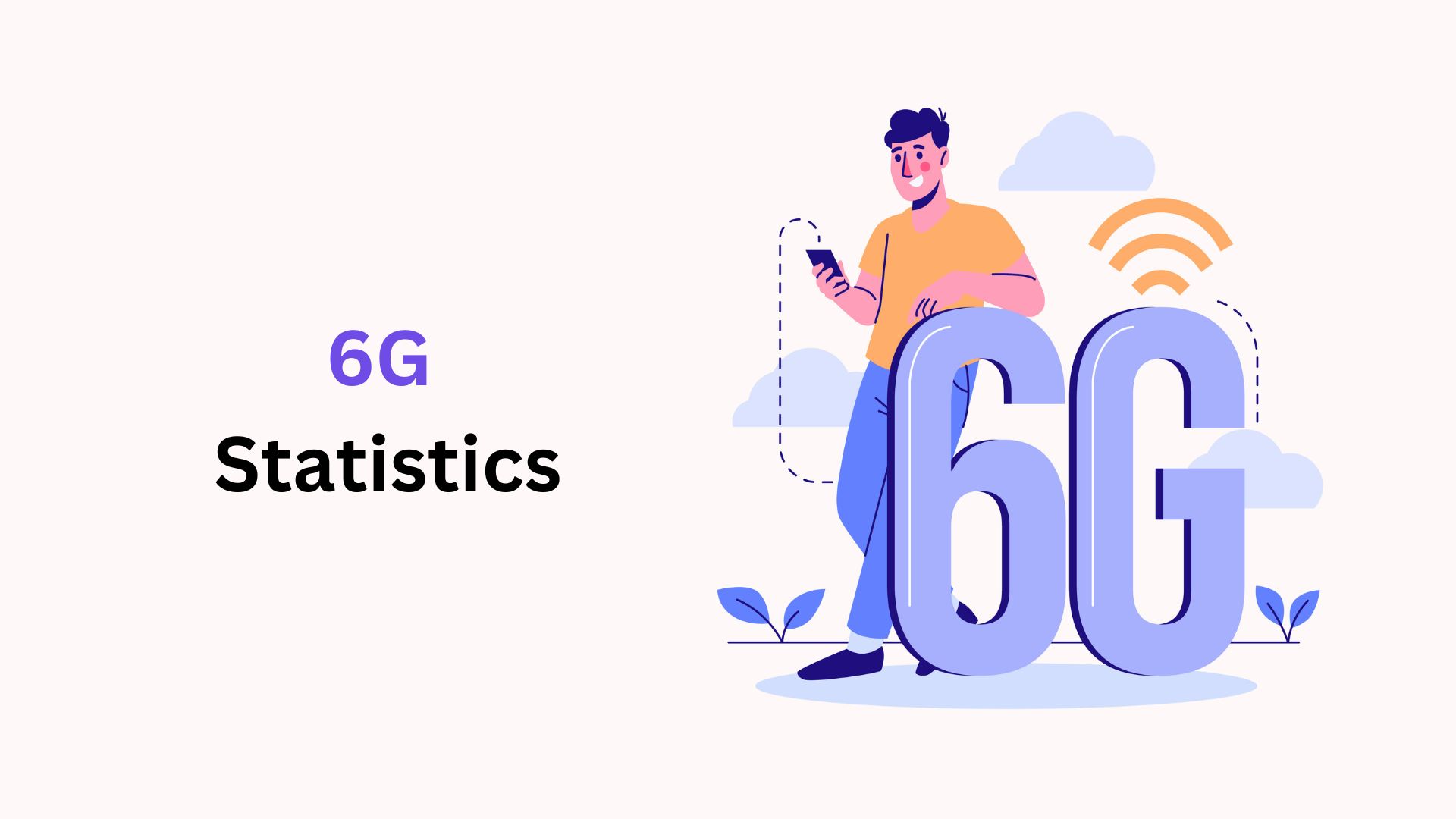
Table of Contents
- Introduction
- Editor’s Choice
- General 6G Statistics
- 6G Market Size
- 6G Market Share by Region
- United States 6G Market Size
- 6G Market Size By Region
- 6G Spectrum Landscape Statistics
- Comparison of 6G With Earlier Mobile Network
- 6G Market Segmental Analysis
- Is the Telecom Sector Doing Enough for 6G?
- 6G Wireless Technology Market Size
- Peak Data Rates Comparison
- Connection Density in 4G, 5G, and 6G Networks
- User Experience Data Rates Statistics
- 6G Transport Network Investment Statistics
- Top Countries by 6G Patents, and 6G Ready Score
- Development Periods of Technology Statistics
- Conclusion
Introduction
6G Statistics: 6G is the next big step in mobile networks and is still being built, but early tests already show very strong performance. It is expected to reach terabit-per-second speeds, cut delays to just microseconds, and connect an enormous number of devices per square kilometre. Because of this, governments, phone companies, and tech firms are investing heavily in 6G research.
This article examines key 6G statistics, including planned data speeds, target latency, spectrum bands, rollout timelines, and market size forecasts. It also reviews how much different regions are spending on research and development. By focusing on real numbers and early trial results, the article shows how 6G is moving from ideas to real progress.
Editor’s Choice
- According to Market.us, the 6G market will reach around USD 10.2 billion by the end of 2025, up from USD 7.7 billion in 2024.
- As of 2024, the North American region held the largest market share at 39%.
- By 2025, the U.S. 6G market will reach around USD 2.28 billion, and by the end of 2034, it will reach USD 16.08 billion, with a CAGR of 24.2% from 2025 to 2034.
- The global 6G wireless technology market is forecast to jump from USD 424.8 million in 2025
- By 2028, the 6G market in North America is expected to be the largest, at about USD 364.12 million, followed by China at about USD 251.14 million.
- For 6G, the current spectrum plans are not final yet, but one is the upper mid-band (FR3) from 7 to 24 GHz.
- In 2024, the mobile handsets accounted for 46% of the total 6G revenue.
- Meanwhile, IoT and edge devices are projected to expand at about 73.22% from 2025 to 2030.
- In 2025, around 38% of respondents believe the current 6G R&D and planning are adequate.
- According to Statista, the highest data speeds in 6G are projected to soar to around 1,000 Gbps (1 Tbps).
General 6G Statistics
- According to scoop.market.us, 6G will use “upper mid-band” spectrum, often called FR3, covering roughly 7 to 24 GHz.
- Frequencies between 7 and 15 GHz are attractive because they propagate through the air similarly to bands just below 7 GHz.
- Engineers are also testing very wide bandwidths, up to 20 GHz, even though they are technically difficult to deploy.
- 6G download speeds are forecast to reach around 1 terabit per second (1000 Gbps), far above 5G’s 100 to 1000 Mbps.
- According to Wikipedia, 6G is planned as the next mobile network after 5G and is defined under the ITU-R IMT-2030 framework.
- The International Telecommunication Union (ITU-R) coordinates work with 3GPP, ETSI, and the NGMN Alliance on future standards.
- 3GPP is finishing Release 18 for “5G Advanced” and moving into Release 19, which starts early 6G research.
- 6G targets faster speeds, lower delay, and better energy efficiency than 5G, using new radio designs, improved coding, and reconfigurable intelligent surfaces.
- Research looks at combining 6G with satellites, Wi-Fi, non-terrestrial networks, and edge computing to support AR, VR, and AI-heavy services.
- Major companies such as Ericsson, Nokia, Huawei, Samsung, LG, Apple, NTT Docomo, Airtel, and Jio are running 6G projects, backed by governments in North America, Europe, and Asia.
- The NGMN Alliance mainly focuses on real user needs and warns against unnecessary replacement of 5G gear, and commercial 6G is expected in the early 2030s.
6G Market Size

(Source: market.us)
- The Global 6G Market is expected to reach USD 69.3 Billion by 2035, rising from USD 4.6 Billion in 2030, supported by a 77.2% CAGR from 2030 to 2035.
- The Ministry of Science and ICT in Korea plans to advance the commercial launch of 6G by two years under the K Network 2030 program through new technology adoption, software based mobile network development, and a stronger network supply chain.
- The ongoing exploration of 6G technology is centered on spectrum allocation in the 7 to 24 GHz upper mid band, also known as FR3, with the 7 to 15 GHz range viewed as favorable due to propagation traits similar to frequencies below 7 GHz.
- The development roadmap for 6G includes consideration of bandwidths up to 20 GHz, despite technical challenges, to support data rates expected to reach 1 TBPS, representing a major jump from the 100 to 1000 Mbps speeds delivered by 5G.
- Expectations for 6G by 2030 include peak data rates of 1000 Gbps, supported by transport network investments projected at USD 505 Million, which reflects the push toward ultra low latency and speeds nearly 1000 times faster than 5G.
- China currently leads global 6G innovation with 35% of all patent filings, exceeding 13,000 applications, while the United States follows closely with 35.2%, and Japan contributes 9.9% of filings.
- The European region is projected to reach a 6G market size of USD 216.21 Million, while the Asia Pacific and Japan market is expected to reach USD 91.66 Million.
- The United Kingdom is anticipated to generate USD 57.01 Million in 6G market value, and the Middle East and Africa market may reach USD 39.83 Million.
- South America is expected to account for USD 26.69 Million in the global 6G market, reflecting early but steady regional progress.
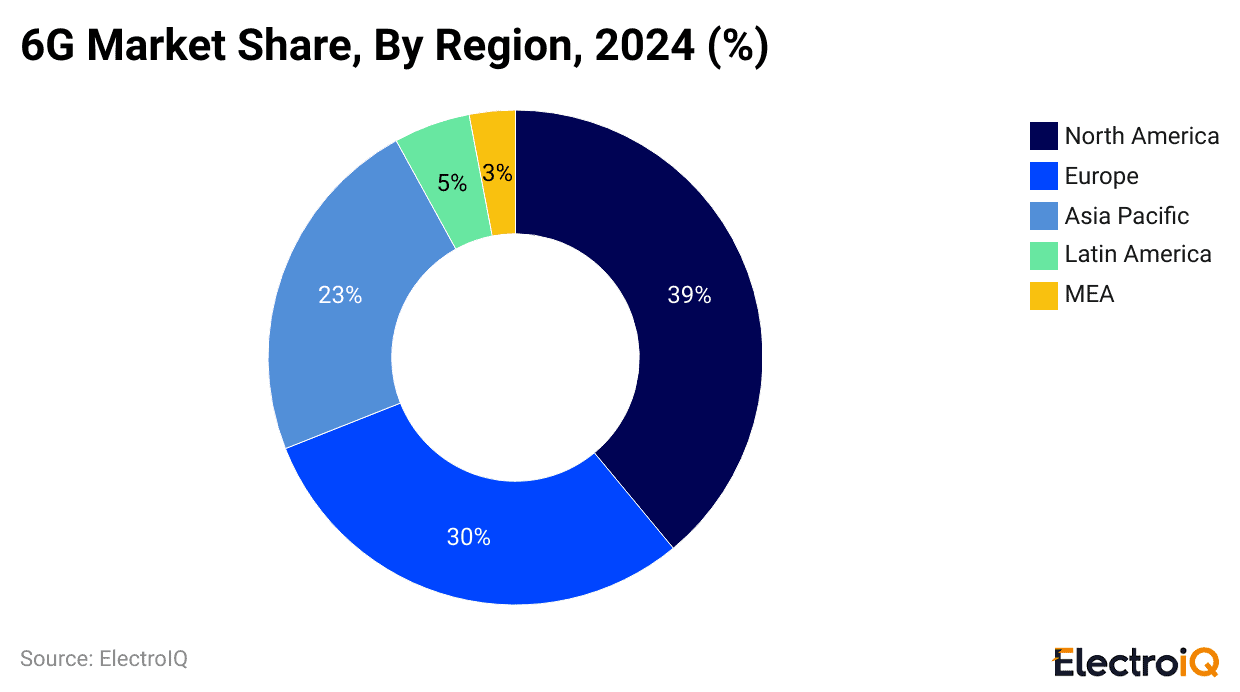
(Reference: Precedence Research)
- As of 2024, the North American region accounted for the largest market share at 39%, followed by the European region at 30%.
- Besides, other regions’ market share includes Asia Pacific (23%), Latin America (5%), and MEA (3%).
United States 6G Market Size
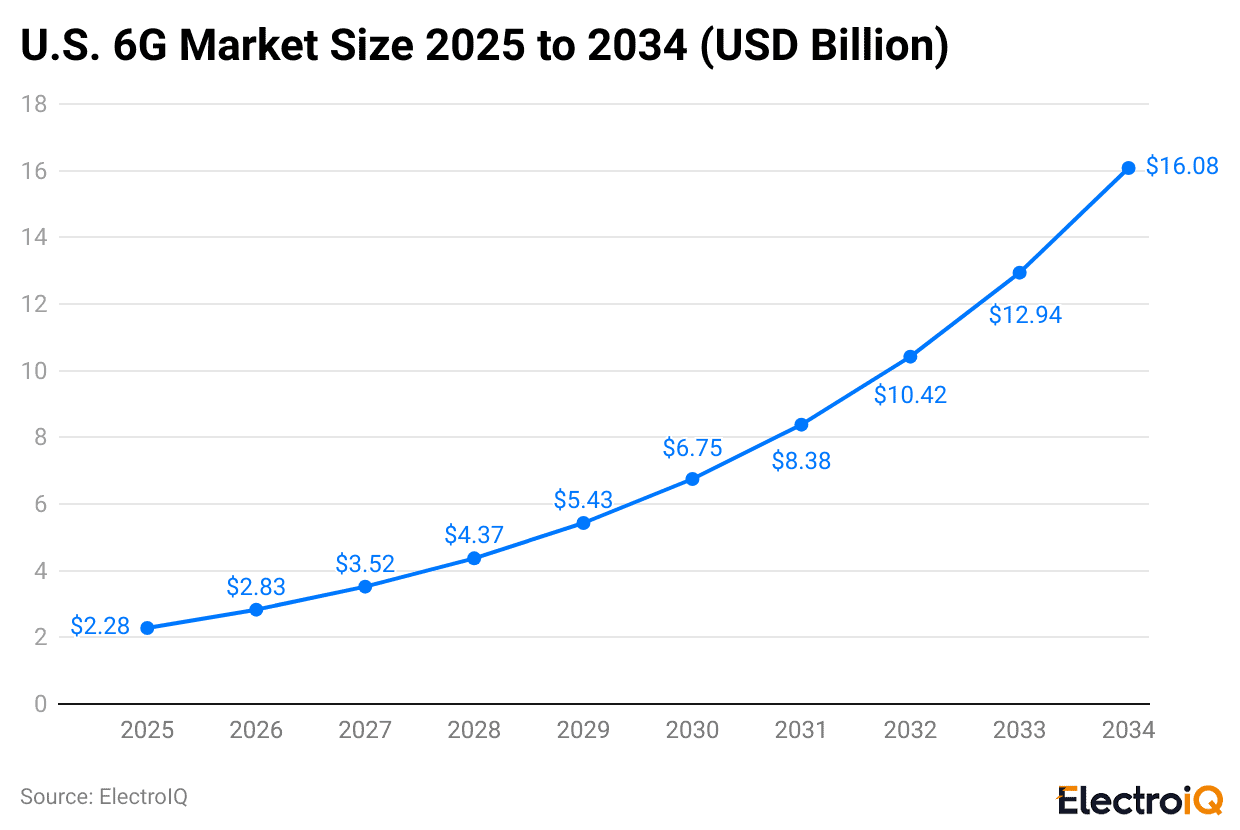
(Reference: Precedence Research)
- By 2025, the U.S. 6G market will reach around USD 2.28 billion, and by the end of 2034, it will reach USD 16.08 billion, with a CAGR of 24.2% from 2025 to 2034.
- Moreover, the market size in the coming years will reach USD 2.83 billion by 2026, USD 3.52 billion by 2027, USD 4.37 billion by 2028, USD 5.43 billion by 2029, USD 6.75 billion by 2030, USD 8.38 billion by 2031, USD 10.42 billion by 2032, USD 12.94 billion by 2033, and USD 16.08 billion by 3034.
6G Market Size By Region
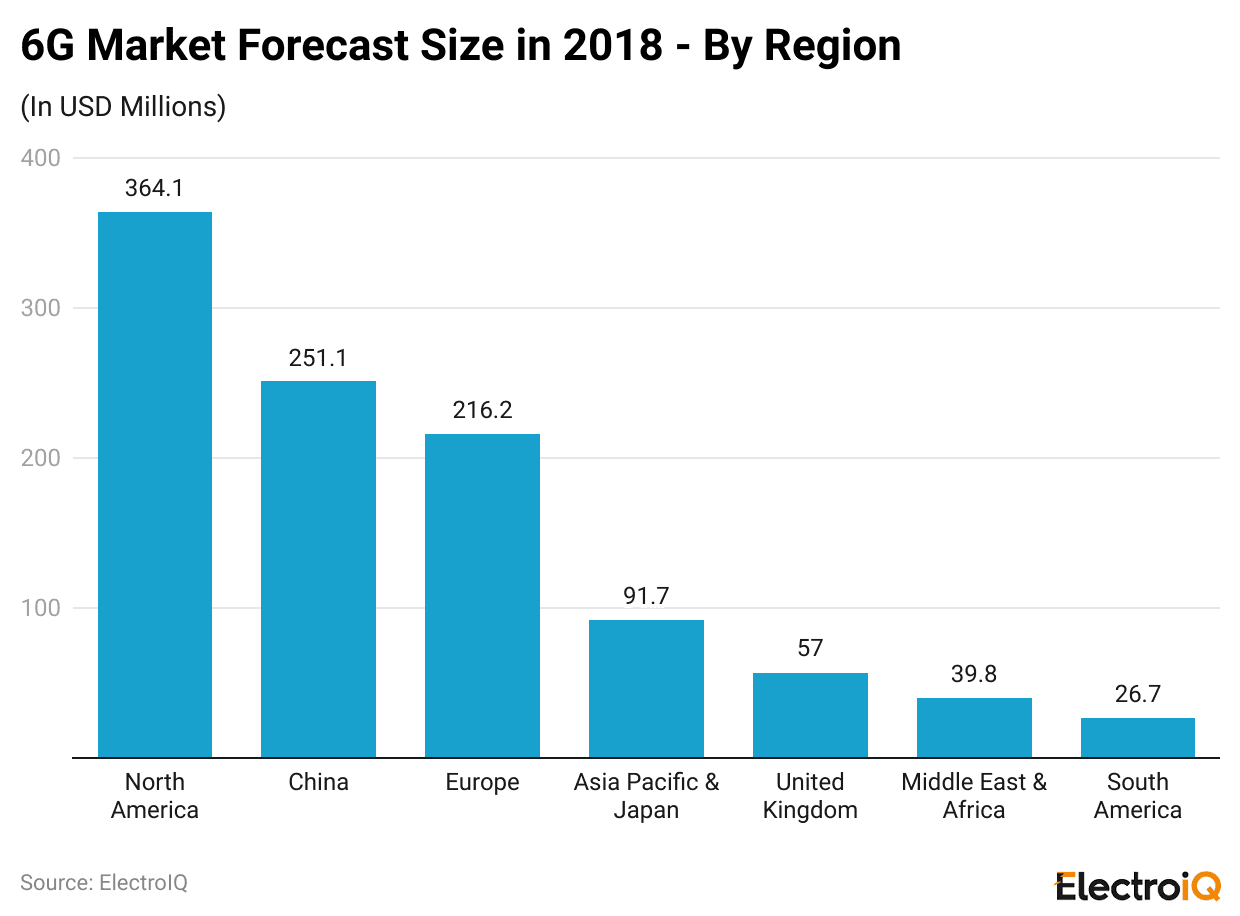
(Reference: Market.us Scoop)
- The above graph shows that by 2028, the 6G market in North America is expected to be the largest, at about USD 364.12 million, followed by China at about USD 251.14 million.
- Europe is expected to be a key 6G region, with about USD 216.21 million, while Asia Pacific & Japan could reach USD 91.66 million.
- The UK may contribute USD 57.01 million, the Middle East & Africa around USD 39.83 million, and South America about USD 26.69 million to the 6G market.
6G Spectrum Landscape Statistics
- According to scoop.market.us, for 6G, the current spectrum plans are not final yet, but one is the upper mid-band (FR3) from 7 to 24 GHz.
- Another is sub-terahertz, with frequencies of 90 to 300 GHz.
- Engineers also aim to reuse and improve bands below 7 GHz through refarming.
By Key Characteristics
| Band Types | Detailed Analysis |
|
Upper mid-band (7 to 24 GHz) |
|
| Sub-terahertz
(90 to 300 GHz) |
|
| Lower bands
(below 7 GHz) |
|
Comparison of 6G With Earlier Mobile Network
- When 6G arrives, the peak speeds are expected to hit 1 terabit per second (1 Tbps), compared with only 100 to 1000 Mbps on 5G.
- End-to-end delay may drop to about 1 ms, while 5G typically targets around 10 ms.
- Spectral efficiency could reach 100 bps/Hz, a big jump over 5G’s 30 bps/Hz.
- User mobility should also improve, with support for speeds up to 1000 km/hr instead of 500 km/hr.
- The maximum operating frequency may reach around 10 THz, compared with around 90 GHz in 5G, enabling XR, THz communication, tactile internet services, and smart, reconfigurable surfaces.
6G Market Segmental Analysis
| Segments | Market Share (2024) | CAGR (2025 to 2030) |
|
Device type |
Mobile handsets accounted for 46% of the total 6G revenue. | IoT and edge devices are projected to expand at about 73.22%. |
| Component | Physical hardware accounted for roughly 54% |
The software portion is expected to rise by around 77.10%. |
|
End-user vertical |
Automotive and transportation made up about 27% | Healthcare deployments are forecast to climb at 72.45%. |
| Frequency band | Sub-terahertz (100-300 GHz) systems accounted for nearly 71%. |
Above 300 GHz, the terahertz band is estimated to grow by 76.15%. |
|
Geography |
The Asia-Pacific region accounted for roughly 36% of 6G revenue. |
This area is anticipated to expand at close to 74.08%. |
Is the Telecom Sector Doing Enough for 6G?
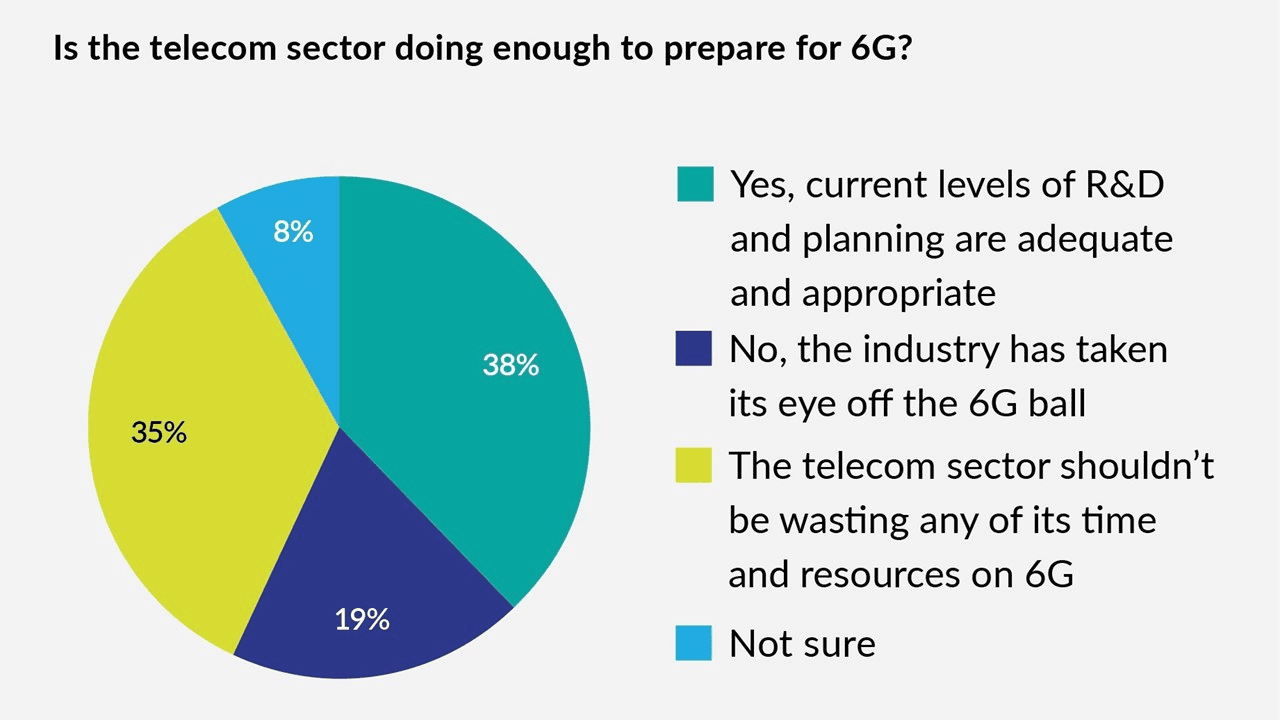
(Source: assets.telecomtv.com)
- The above chart shows 38% of respondents believe the current 6G R&D and planning are adequate.
- About 19% think the industry has taken its eye off the 6G, while 35% feel telecom companies shouldn’t spend time or money on 6G at all.
- Only 8% remain unsure about how well the sector is preparing.
6G Wireless Technology Market Size
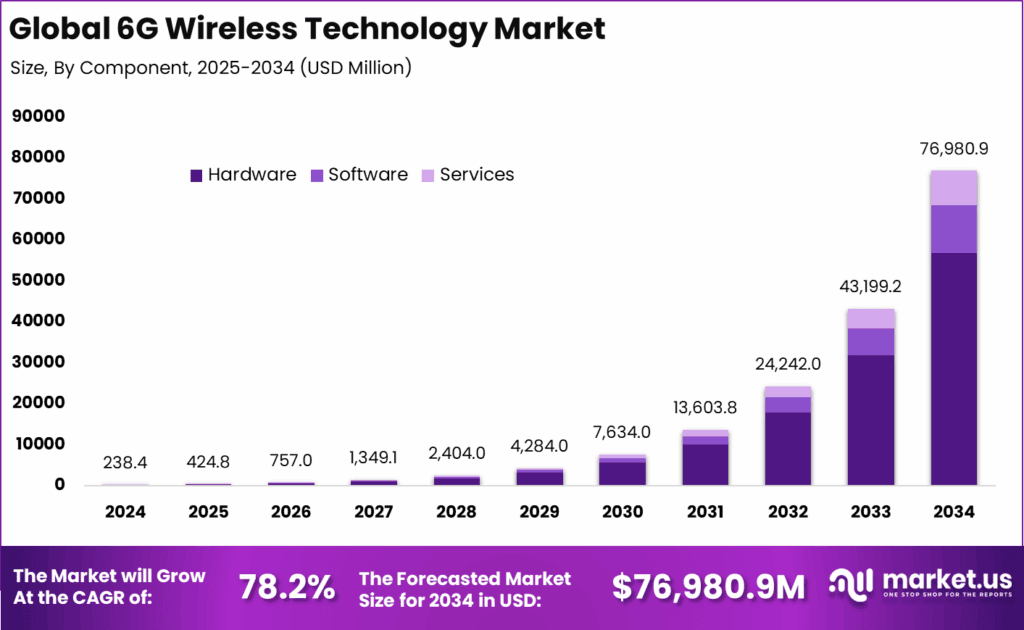
(Source: market.us)
- The Global 6G Wireless Technology Market is projected to reach USD 76,980.9 million by 2034, up from USD 238.4 million in 2024. This growth is supported by a robust CAGR of 78.2% from 2025 to 2034. In 2024, the Asia Pacific region accounted for 39.2% of the market, generating USD 93.45 million in revenue.
- Spectrum allocation for 6G is expected to expand into the 7 to 24 GHz (FR3) range, with particular interest in the 7 to 15 GHz band. This band offers propagation characteristics similar to sub-7 GHz frequencies while providing higher capacity.
- Research is underway on bandwidth blocks reaching up to 20 GHz for 6G, with these wide channels anticipated to support advanced services, despite introducing significant engineering and device design challenges.
- In terms of data rates, 6G is expected to achieve speeds of 1 Tbps, a considerable leap from the typical range of 100 to 1000 Mbps seen in 5G. Peak rates nearing 1000 Gbps are projected to significantly enhance mobile broadband performance.
- Infrastructure investment is forecasted to increase in line with these advancements, with transport network spending expected to reach approximately USD 505 million by 2030 to support high-capacity, low-latency 6G backhaul and core networks.
- In June 2025, Ericsson unveiled new 6G prototypes that incorporate Integrated Sensing and Communication as well as photonic radios. These developments position 6G as a convergence of communication, sensing, and AI, with demonstrations focusing on ultra-low latency, real-time environmental awareness, and efficient utilization of high-frequency spectrum.
- In 2024, the Hardware segment dominated the market with a 73.98% share, underscoring the critical role of advanced chipsets, antennas, base stations, and devices in the early stages of 6G development.
- The THz spectrum segment represented 78.1% of the market, highlighting its importance as the foundational layer for ultra-high-speed, short-range 6G connectivity.
- The Enhanced Mobile Broadband application segment comprised 56.3% of the market, driven by increasing demand for immersive services, high-resolution streaming, and data-intensive applications.
- The Telecommunications end-use sector captured 62.1% of the market, indicating that network operators and telecom vendors are the primary investors and early adopters of 6G technologies.
- In China, the 6G market was valued at USD 45.05 million in 2024 and is projected to grow at an impressive CAGR of 84.4%. This growth is supported by strong governmental policies, large-scale trials, and consistent investment in next-generation wireless innovations.
- Overall, the Asia Pacific region continues to hold the largest market share at 39.2%, driven by robust research activity, government-funded initiatives, and early deployment programs across major economies in the area.
Peak Data Rates Comparison
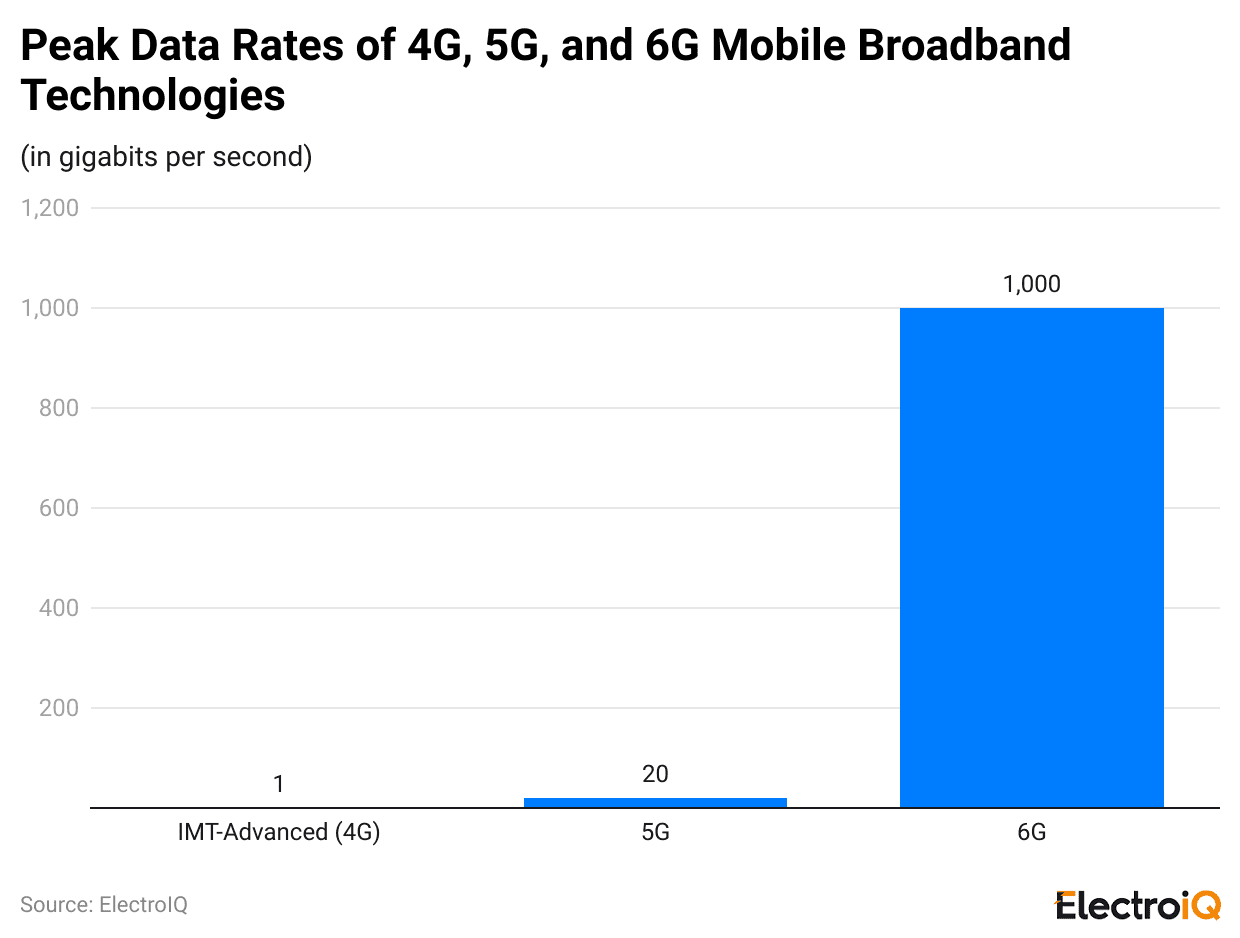
(Reference: statista.com)
- The chart shows that the highest data speeds in 6G are projected to soar to around 1,000 Gbps (1 Tbps).
- 5G boosts this to roughly 20 Gbps, enabling much faster downloads and smoother streaming.
- 4G (IMT-Advanced) reaches a peak of about 1 Gbps, with a big step up from earlier systems.
Connection Density in 4G, 5G, and 6G Networks
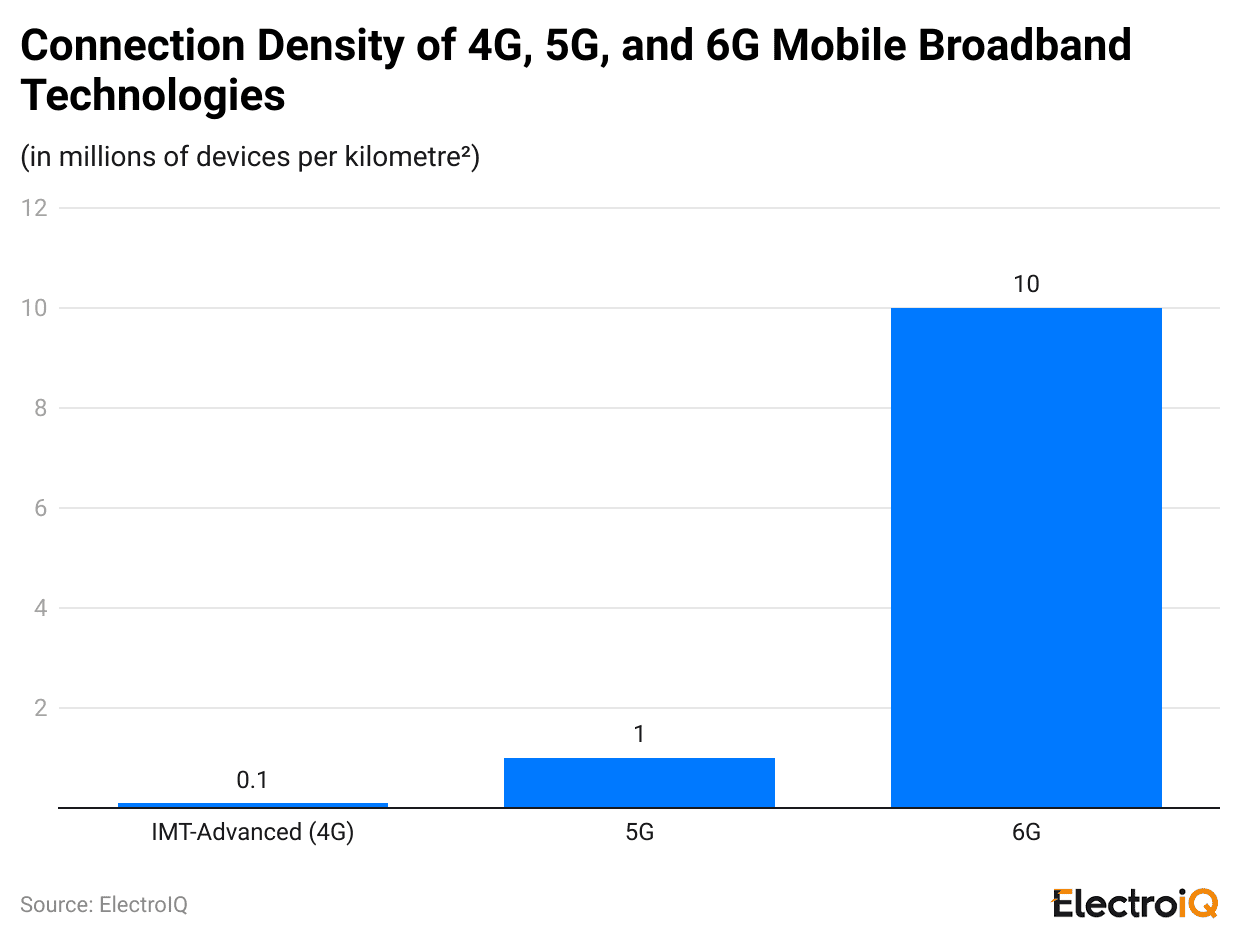
(Reference: statista.com)
- 4G network connects about 0.1 million devices per square kilometre, while 5G networks remain close to 1 million.
- The future 6G network aims for approximately 10 million devices per square kilometre.
User Experience Data Rates Statistics

(Reference: scoop.market.us)
- For 4G (IMT-Advanced), typical user data rates are around 10 Mbps, while 5G boosts this to about 100 Mbps.
- Furthermore, 6G is expected to deliver around 1,000 Mbps (1 Gbps) to users.
6G Transport Network Investment Statistics
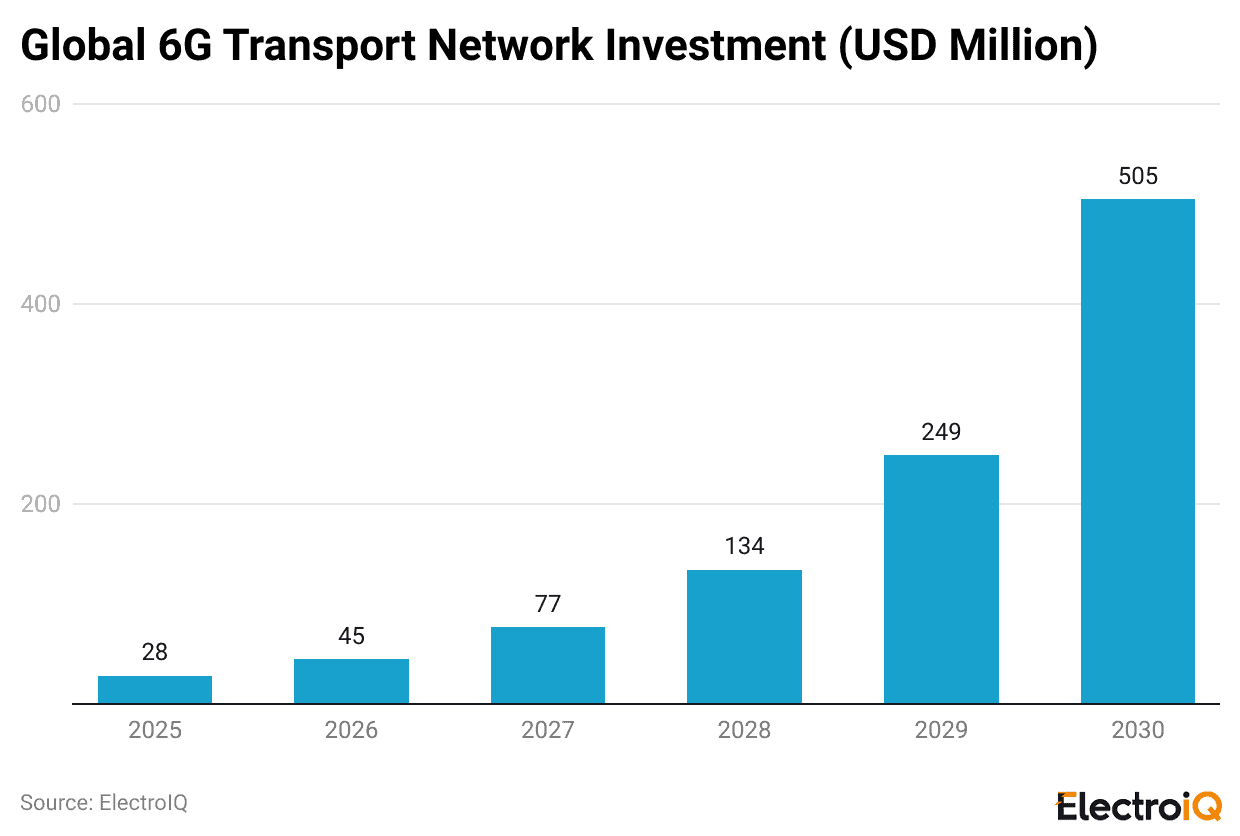
(Reference: scoop.market.us)
- The global investment in 6G transport networks is expected to reach around USD 28 million by 2025.
- The estimated investments in the coming years are as follows: USD 45 million (2026), USD 77 million (2027), USD 134 million (2028), USD 249 million (2029), and USD 505 million (2030).
Top Countries by 6G Patents, and 6G Ready Score
- South Korea recorded 760 active 6G patents and achieved a 6G Ready Score of 8.75, indicating strong progress in next-generation wireless innovation.
- India reached 265 documented 6G patents with a 6G Ready Score of 7.50, reflecting steady advancement supported by national R&D programs.
- The United States registered 2,229 filed 6G patents and maintained a 6G Ready Score of 6.88, showing consistent development driven by its telecom and semiconductor ecosystem.
- China led globally with 4,604 6G patents and reported a 6G Ready Score of 5, showing that wide patent ownership is present even as readiness efforts continue to evolve.
- The United Kingdom recorded 115 patents in 6G technologies while progressing toward readiness without a disclosed score in this dataset.
- Japan documented 155 patents and reached a 6G Ready Score of 3.75, showing active participation in global 6G research.
- Finland registered 12 patents and continued groundwork for 6G deployment although a readiness score was not listed here.
- Germany filed 77 6G patents and achieved a 6G Ready Score of 3.13, supported by its industrial research capabilities.
- Australia reported 55 patents and maintained a 6G Ready Score of 1.25, reflecting early-stage readiness efforts in the transition toward future 6G networks.
| Country | 6G Patents | 6G Ready Score |
|
South Korea |
760 | 8.75 |
| India | 265 |
7.50 |
|
United States |
2,229 | 6.88 |
| China | 4,604 |
5 |
|
United Kingdom |
115 | |
| Japan | 155 |
3.75 |
|
Finland |
12 | |
| Germany | 77 |
3.13 |
|
Australia |
55 |
1.25 |
Development Periods of Technology Statistics

(Reference: statista.com)
- The chart shows that 3G took about 15 years to develop, while 4G took 12.
- The 5G and upcoming 6G networks will each require approximately 8 years of development.
Conclusion
To sum up, today’s 6G numbers show a technology that is still new but growing very quickly. Spending on research, the number of patents, and test networks are all increasing, which proves that governments, telecom companies, and device makers are serious about 6G.
Early estimates of speed, delay, spectrum use, and device density hint at technologies such as holographic calls, massive digital twins, and always-on AI. At the same time, high costs, limited spectrum, power consumption, and security issues remain major hurdles that must be addressed.
FAQ.
Most experts expect early commercial 6G networks around 2030, with trials in the late 2020s.
Studies aim for top speeds of up to 1 Tbps (terabit per second) under ideal conditions, which is much faster than 5G.
6G could power holograms, immersive AR/VR, precise city twins, remote surgery, and AI-driven massive IoT.
6G is expected to use sub-6 GHz, millimetre-wave, and especially sub-terahertz and terahertz spectrum bands.
In the European Union, the United States, China, Japan, and South Korea, industry and governments heavily finance 6G research.

Maitrayee Dey has a background in Electrical Engineering and has worked in various technical roles before transitioning to writing. Specializing in technology and Artificial Intelligence, she has served as an Academic Research Analyst and Freelance Writer, particularly focusing on education and healthcare in Australia. Maitrayee's lifelong passions for writing and painting led her to pursue a full-time writing career. She is also the creator of a cooking YouTube channel, where she shares her culinary adventures. At Smartphone Thoughts, Maitrayee brings her expertise in technology to provide in-depth smartphone reviews and app-related statistics, making complex topics easy to understand for all readers.







